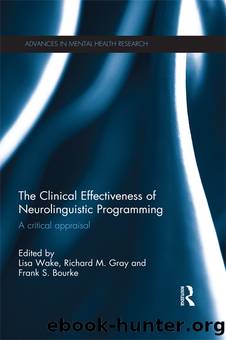The Clinical Effectiveness of Neurolinguistic Programming by Wake Lisa;Gray Richard;Bourke Frank;Gray Richard;

Author:Wake, Lisa;Gray, Richard;Bourke, Frank;Gray, Richard;
Language: eng
Format: epub
ISBN: 1125257
Publisher: Taylor & Francis Group
An NLP model of change for depressive disorder
While it must be acknowledged that certain levels of depression may be non-amenable to behavioral interventions, for many cases of depression, NLP techniques can be very useful. Recalling that every remembered experience and every imagined experience is a potential resource, many clients can be taught to model their own or otherâs behaviors (Andreas and Andreas, 1987, 1989; Bandler and Grinder, 1975a, b).
From the clientâs perspective, NLP can model the perspective of clients who have managed to resolve their depressive state or disorder, which can then be mapped across for clients who are unable to resolve their depression. Equally, a client can be encouraged to model their own strategy for how in the past, they have changed from a depressed mood to normal emotional modulation, from diminished interest/pleasure in almost all activities to a motivated and active person; from not controlled to a balanced diet and weight; from sleep disorder to a normal sleep; from fatigue or loss of energy to an energetic active life; from feelings of worthlessness or inappropriate guilt to assertive communication; from impaired ability to concentrate or indecisiveness to focused and appropriate decision-making behavior; and from recurrent thoughts of death and suicidal ideation to enjoying life and value oriented actions.
From the therapistâs point of view, many of the strategies and intervention frames in NLPt come from modeling the patterns of the therapists that managed to help their clients get rid of symptoms, including those of depression. As we have already demonstrated, there are components found in other therapies that either emerged from NLP or have influenced NLP. An NLPt psychotherapist sees every successful client as a possible model. Pure observation of such intervention patterns like dissociation used in phobia techniques, the outcome intervention, adaptation of sensory experience, the utilization of eye patterns, were then used in clinical fields for psychotherapeutic interventions for depression. Modeling enables a cognitive description of a process that therapeutically happens over a number of sessions. No therapist would apply the reframing interventions without having a good relationship and a basic understanding of the clientâs history. The therapeutic relationship and relationship interventions are mandatory for the therapeutic process even if it is not described per se in the technique manuals.
NLPt provides a perspective on depression that is based not on what is not working and a specific diagnosis, but on the success strategies related to energy, negative thoughts and beliefs, relationship patterns, identity and self-esteem, resource management, successful outcome work, positive visualizations, etc. NLPt as an intervention in depression can be effective when the needed resources are in place in order to balance the depressive patterns. In an ideal situation the client is encouraged to access an excellence state: in which the mind and its expression in linguistic and sensory representation is influencing the body and physiology. This is the âstate goalâ leading to better physiological and psychological health.
The criteria for therapeutic outcomes in NLPt include the following:
â¢A clear therapeutic goal that the client is motivated to achieve.
Download
This site does not store any files on its server. We only index and link to content provided by other sites. Please contact the content providers to delete copyright contents if any and email us, we'll remove relevant links or contents immediately.
Unwinding Anxiety by Judson Brewer(72055)
The Art of Coaching by Elena Aguilar(52240)
The Fast Metabolism Diet Cookbook by Haylie Pomroy(20929)
Rewire Your Anxious Brain by Catherine M. Pittman(18336)
Healthy Aging For Dummies by Brent Agin & Sharon Perkins RN(16933)
Talking to Strangers by Malcolm Gladwell(12912)
The Art of Thinking Clearly by Rolf Dobelli(9951)
Crazy Rich Asians by Kevin Kwan(8912)
Mindhunter: Inside the FBI's Elite Serial Crime Unit by John E. Douglas & Mark Olshaker(8748)
The Compound Effect by Darren Hardy(8541)
Periodization Training for Sports by Tudor Bompa(7939)
Becoming Supernatural by Dr. Joe Dispenza(7864)
Tools of Titans by Timothy Ferriss(7848)
Wonder by R. J. Palacio(7755)
Crystal Healing for Women by Mariah K. Lyons(7733)
Bodyweight Strength Training by Jay Cardiello(7686)
Therapeutic Modalities for Musculoskeletal Injuries, 4E by Craig R. Denegar & Ethan Saliba & Susan Saliba(7605)
Should I Stay or Should I Go? by Ramani Durvasula(7439)
Change Your Questions, Change Your Life by Marilee Adams(7399)
